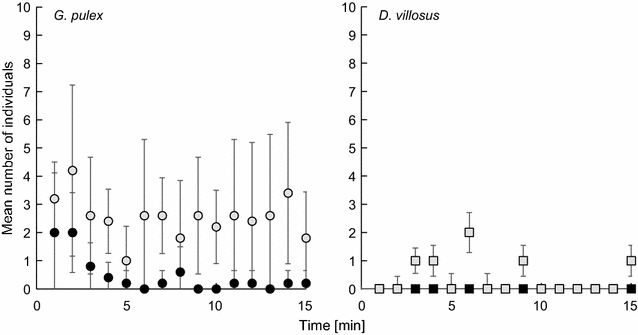Synergistic impacts by an invasive amphipod and an invasive fish explain native gammarid extinction
- PMID: 27417858
- PMCID: PMC4946187
- DOI: 10.1186/s12898-016-0088-6
Synergistic impacts by an invasive amphipod and an invasive fish explain native gammarid extinction
Abstract
Background: Worldwide freshwater ecosystems are increasingly affected by invasive alien species. In particular, Ponto-Caspian gobiid fishes and amphipods are suspected to have pronounced effects on aquatic food webs. However, there is a lack of systematic studies mechanistically testing the potential synergistic effects of invasive species on native fauna. In this study we investigated the interrelations between the invasive amphipod Dikerogammarus villosus and the invasive fish species Neogobius melanostomus in their effects on the native amphipod Gammarus pulex. We hypothesized selective predation by the fish as a driver for displacement of native species resulting in potential extinction of G. pulex. The survival of G. pulex in the presence of N. melanostomus in relation to the presence of D. villosus and availability of shelter was analyzed in the context of behavioural differences between the amphipod species.
Results: Gammarus pulex had a significantly higher susceptibility to predation by N. melanostomus compared to D. villosus in all experiments, suggesting preferential predation by this fish on native gammarids. Furthermore, the presence of D. villosus significantly increased the vulnerability of G. pulex to fish predation. Habitat structure was an important factor for swimming activity of amphipods and their mortality, resulting in a threefold decrease in amphipods consumed with shelter habitat structures provided. Behavioral differences in swimming activity were additionally responsible for higher predation rates on G. pulex. Intraguild predation could be neglected within short experimental durations.
Conclusions: The results of this study provide evidence for synergistic effects of the two invasive Ponto-Caspian species on the native amphipod as an underlying process of species displacements during invasion processes. Prey behaviour and monotonous habitat structures additionally contribute to the decline of the native gammarid fauna in the upper Danube River and elsewhere.
Keywords: Anti-predator behaviour; Dikerogammarus villosus; Gammarus pulex; Neogobius melanostomus; Selective predation; Species displacement.
Figures





Similar articles
-
Superior predatory ability and abundance predicts potential ecological impact towards early-stage anurans by invasive 'Killer Shrimp' (Dikerogammarus villosus).Sci Rep. 2021 Feb 25;11(1):4570. doi: 10.1038/s41598-021-82630-5. Sci Rep. 2021. PMID: 33633148 Free PMC article.
-
Metabolic activity and behavior of the invasive amphipod Dikerogammarus villosus and two common Central European gammarid species (Gammarus fossarum, Gammarus roeselii): Low metabolic rates may favor the invader.Comp Biochem Physiol A Mol Integr Physiol. 2016 Jan;191:119-126. doi: 10.1016/j.cbpa.2015.10.015. Epub 2015 Oct 16. Comp Biochem Physiol A Mol Integr Physiol. 2016. PMID: 26478193
-
Keep calm and don't stop growing: Non-consumptive effects of a sympatric predator on two invasive Ponto-Caspian gammarids Dikerogammarus villosus and Pontogammarus robustoides.PLoS One. 2017 Aug 3;12(8):e0182481. doi: 10.1371/journal.pone.0182481. eCollection 2017. PLoS One. 2017. PMID: 28771578 Free PMC article.
-
Twenty years of invasion: a review of round goby Neogobius melanostomus biology, spread and ecological implications.J Fish Biol. 2012 Feb;80(2):235-85. doi: 10.1111/j.1095-8649.2011.03157.x. J Fish Biol. 2012. PMID: 22268429 Review.
-
The Impacts of Invasive Crayfish and Other Non-Native Species on Native Freshwater Crayfish: A Review.Biology (Basel). 2024 Aug 12;13(8):610. doi: 10.3390/biology13080610. Biology (Basel). 2024. PMID: 39194548 Free PMC article. Review.
Cited by
-
The Braveheart amphipod: a review of responses of invasive Dikerogammarus villosus to predation signals.PeerJ. 2018 Aug 2;6:e5311. doi: 10.7717/peerj.5311. eCollection 2018. PeerJ. 2018. PMID: 30083455 Free PMC article.
-
Invasion strategies in round goby (Neogobius melanostomus): Is bigger really better?PLoS One. 2018 Jan 5;13(1):e0190777. doi: 10.1371/journal.pone.0190777. eCollection 2018. PLoS One. 2018. PMID: 29304159 Free PMC article.
-
The hunter and the hunted-A 3D analysis of predator-prey interactions between three-spined sticklebacks (Gasterosteus aculeatus) and larvae of different prey fishes.PLoS One. 2021 Aug 26;16(8):e0256427. doi: 10.1371/journal.pone.0256427. eCollection 2021. PLoS One. 2021. PMID: 34437615 Free PMC article.
-
Effects of the herbicide Roundup® on the metabolic activity of Gammarus fossarum Koch, 1836 (Crustacea; Amphipoda).Ecotoxicology. 2018 Nov;27(9):1249-1260. doi: 10.1007/s10646-018-1978-5. Epub 2018 Sep 6. Ecotoxicology. 2018. PMID: 30191520
-
Continuity of chronic predation risk determines changes in prey physiology.Sci Rep. 2020 Apr 24;10(1):6972. doi: 10.1038/s41598-020-64000-9. Sci Rep. 2020. PMID: 32332831 Free PMC article.
References
-
- Keller RP, Geist J, Jeschke JM, Kühn I. Invasive species in Europe: ecology, status and policy. Environ Sci Eur. 2011;23(23):1–17.
-
- Wolter C, Röhr F. Distribution history of non-native freshwater fish species in Germany: how invasive are they? J Appl Ichthyol. 2010;26(Suppl. 2):19–27. doi: 10.1111/j.1439-0426.2010.01505.x. - DOI
-
- Sindilariu PD, Freyhof J, Wolter C. Habitat use of juvenile fish in the lower Danube and the Danube Delta: implications for ecotone connectivity. Hydrobiologia. 2006;571:51–61. doi: 10.1007/s10750-006-0216-y. - DOI
-
- Bijdevaate A, Jazdzewski K, Ketelaars HAM, Gollasch S, Vander Velde G. Geographical patterns in range extension of Ponto-Caspian macroinvertebrate species in Europe. Can J Fish Aquat Sci. 2002;59:1159–1174. doi: 10.1139/f02-098. - DOI
Publication types
MeSH terms
Associated data
LinkOut - more resources
Full Text Sources
Other Literature Sources

